We’re pleased to have another guest article for you today, this time by Russian author Maxim Popenker (you may recognize him from his encyclopedic web site of firearms, world.guns.ru). He got his hands on a silenced Russia PB pistol, something we have very little chance of seeing over here in the US, and offered us this writeup:
Guns of the Spetsnaz – 9mm PB silenced pistol
by Maxim Popenker
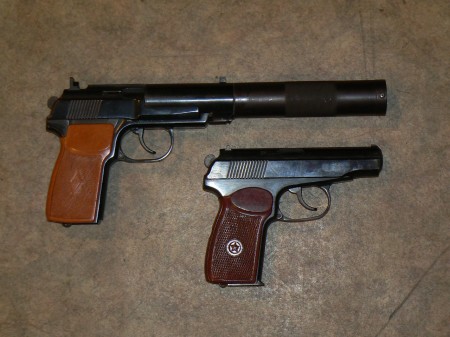
Soviet (Red) army and NKVD (Internal affairs) troops began to use silenced weapons during the WW2. Those weapons included the Mosin M1891/30 rifle and Nagant M1895 revolver, both fitted with Maxim-type quick-detachable silencers known as “Pribor Bramit” (Bramit device; Bramit was an acronym for Mitin brothers who developed the unit). The M1891/30 rifles were used with special subsonic ammunition (often handloaded by troops; process involved disassembling of the standard round, removing most of the power charge and filling the empty space with some inert filler). Silenced Nagant revolvers were most often used with special ammunition, loaded to standard velocities (which happened to be subsonic) but loaded with pointed bullet which ensured longer service life of the rubber baffle used in the Bramit silencer.
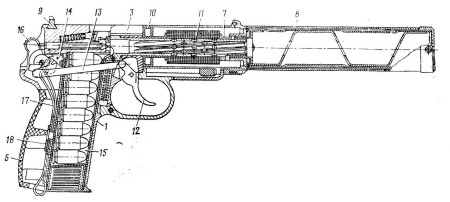
For some period after the WW2 the silenced weaponry disappeared from the Soviet military scene, as the minds were mostly occupied with stuff like nuclear bombs and missiles. However, appearance of the NATO tactical nuclear missiles, which were located in Europe and aimed at USSR, brought to life an idea of missile killers – elite stealth units capable of infiltration into the enemy territories to strike at missile launchers, C&C posts and ammunition dumps at the moment of “Hour X”. Obviously, such troops, known as “Voiska Spetsialnogo Naznachenija” (Special purpose troops) or Spetsnaz in short, required some special weapons to operate in stealth mode, and silenced pistols were on the top of their shopping list.
The integrally silenced PB (Pistolet Beschumnyj – noiseless pistol, official military index 6P9) was introduced in 1967 for use by various Spetsnaz units. Manufacture of the PB pistols was stopped in the mid-eighties, but was resumed about fifteen years later due to constant demand for such specialized weapons. It was and still is made at the same factory that makes PM pistols – the Izhevsk Mechanical Plant.
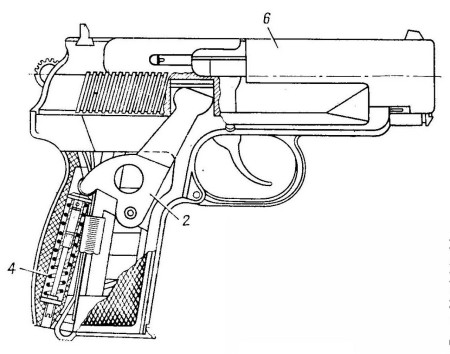
The PB is based on the Makarov PM but heavily modified to accept a semi-integral silencer of unusual design. The pistol is designed to fire standard 9×18 PM ammunition, and to ensure that the velocity of the bullets remains subsonic regardless of the external conditions (i.e. temperature), the barrel has small ports that allow some of propellant gas to escape into the rear part of the silencer. The front part of the silencer can be quickly detached and is mounted onto the rear part by the means of an interrupted thread lock. The front part of the silencer contains three steel baffles which are formed from sheet steel as a single removable unit, and, while the pistol is intended to be fired with both parts of the silencer in place, in emergency situations it also can be safely fired without the front part of the silencer. The sound signature in this case will be more significant, of course.
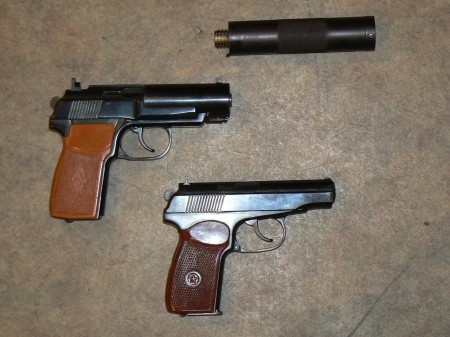
The latch for front part of the silencer is located at the front of the frame, just below the rear part of the silencer. The rear part of the silencer is filled with rolled steel mesh, which acts as a heat sink for powder gases. The rear part of the silencer, that surrounds the ported barrel, is removed only for maintenance and inspection, and for safety reasons pistol cannot be fired with the rear part of the silencer removed. Use of an integral silencer resulted in a short slide; because of that, the return spring is located inside the plastic grip panel, at its rear, and linked to the slide by the long swinging lever which is located at the right side of the grip frame, under the grip panel. The trigger unit is similar to the one used in the Makarov pistol, with a double-action trigger, an exposed hammer and a slide-mounted safety/decocker. Magazines also are the same as in the Makarov PM. The button located at the base of the trigger-guard, on the left side of the grip, is not a magazine release – it is used to remove the grip panels for disassembly and maintenance. The magazine release is located at the base of the grip. Sights are fixed, with drift-adjustable rear blade, and equipped with two-dot luminous inserts (one dot at the rear sight under the notch, one on front sight) for night shooting. Grip panels were of wrap-around U-pattern, similar in shape but not interchangeable with grips of Makarov PM pistol. PB grips were usually made from brown-red plastic and featured checkered surfaces with diamond-shaped symbol in the middle that replaced standard star of the PM grips.
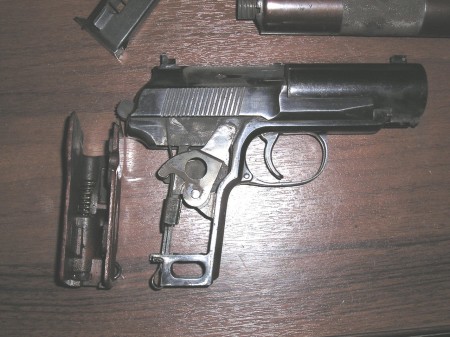
PB pistols were issued with special flap-type leather holsters which had additional compartments for a separated front part of the silencer and a spare magazine. PM-type cleaning rod was attached to the outside of the holster by two leather loops.
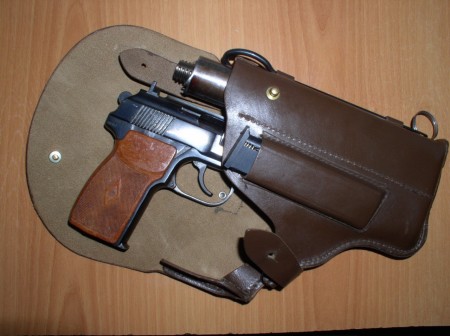
Disassembly for cleaning, inspection and maintenance was similar to the PM pistol, with additional steps to remove and disassemble the silencer and grip panels.
Technical Data
Trigger type: Double/single action
Caliber/ammunition used: 9x18mm Makarov
Weight, empty: 970g (34 oz)
Length, fully assembled: 310mm (12.2 in)
Length, front silencer removed: 170mm (6.7 in)
Barrel length: 105mm (4.1 in)
Magazine capacity: 8 rounds
Firing the PB
I had the chance to fire PB at a military facility in Russia, and found the experience quite enjoyable. The report of the gun, when fully assembled, is somewhat similar to the sound of the average airgun, except for the relatively loud metallic sound of the slide cycling back and forth. Ear protection is not mandatory when firing the PB. Accuracy in both slow and rapid fire at 25 meters was somewhat better than with standard Makarov pistol, probably because of better (larger) sights and more muzzle-heavy balance which helped to recover from recoil for faster follow-up shots. The standard issue holster is good at keeping the gun protected from elements and strapped to the body, but requires some time to assemble the gun for action. I know that some real-life operators simply cut off the bottom of the holster so the gun could be holstered with the silencer attached, if it is required by tactical situation. I also heard about some hand-made shoulder holsters for PB, which allowed to carry assembled gun in vertical position, with muzzle down, although newer saw any of them.
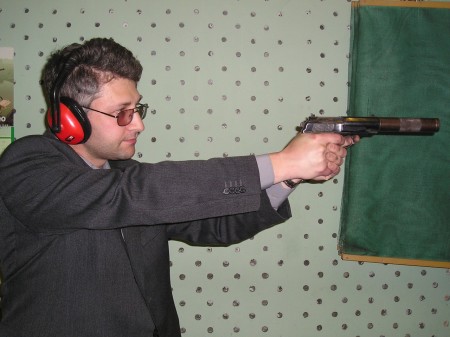
Want to see more of Max’s work? He has several print books written in cooperation with noted ammunition expert Anthony Williams available for sale, including:
Assault Rifle: The Development of the Modern Military Rifle and its Ammunition
Machine Gun: The Development of the Machine Gun from the Nineteenth Century to the Present Day
Modern Combat Pistols: The Development of Semi-automatic Pistols for Military and Police Service Since 1945
and
Sub-Machine Gun: The Development of Sub-Machine Guns and their Ammunition from World War 1 to the Present Day (we also have a video review of this one)


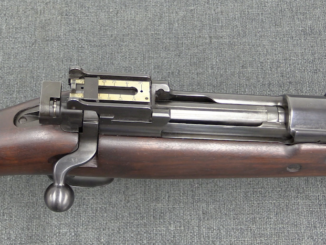
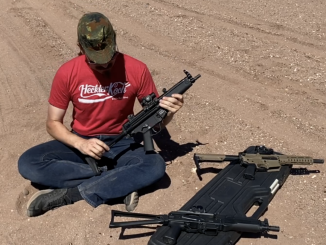
Many thanks to Max and Ian for a well-written and informative article. I always did like the 9mm Makarov PM for its functionality and workhorse reliability. I’m also guessing that this silenced PB version is probably seeing widespread use in counter-terrorism operations.
Excellent article. Thank you very much for this very good description.
This was very interesting. Thank you to Mr. Popenker for this very detailed explanation. The return spring is quite fascinating, and I wouldn’t have recognized it for what it is without reading the explanation. I suppose it makes sense that you can’t wrap the return spring around the barrel (as normal) if you are venting hot gases into that space.
I can understand the need to be able to holster the pistol fully assembled. A pistol is a short range weapon, so the operator may need to bring it to bear or switch to another weapon very quickly. This means there would often not be time to assemble or disassemble it. On the other hand, the ability to disassemble it makes it much more convenient to carry under normal (non operational) circumstances. That is something that perhaps should have resulted in an official solution after receiving user feedback.
While we’re on the subject of Russian pistols, I wonder if Ian could arrange for an article from someone on the PMM version of the Makarov and its improved ammunition? It is a very interesting weapon that *almost* replaced the PM version as the standard Russian service pistol but had to be withdrawn at the last minute and replaced by a completely different pistol. Maxim Popenker has some information on it on his web site, but an article dedicated to its history would be fascinating as to how it became a “forgotten weapon”.
I would like to have a Makarov PMM as a CCW, but they are just unavaliable.
Probably used to great effect in the killing fields of the Katyn Forest and the cellars of Lubyanka Prison.
CB in FL….Never Forget – The Soviets and their stooges were worse killers than the Nazis.
Man, are you time traveler or smoking something?
This gun was adopted 22 years after the end of WW2, and, IIRC, death sentences in USSR were executed by much more conventional Nagant or PM pistols.
And let’s keep politics away, right? We can go long and unpleasant ways pointing at state crimes and genocides conducted by certain now-democratic countries in the past, and being conducted (albeit at much smaller scale) right now.
Actually, the Poles whacked in Katyn were shot by Soviet secret police, but not with Soviet guns. They were shot with .32 ACP caliber weapons, probably Walther PPs that were supplied during the period of the Molotov-Ribbentrop pact. This was presumably because foreign weapons are “deniable” and, indeed, when the Katyn graves were found, the Soviet line was that Nazis did them to frame the USSR, until the end of the USSR when the short-lived Yeltsin government released numerous documents about the massacres. (Including the handwritten order to do it, in Stalin’s handwriting).
I think we can all agree that Stalin was a nasty fellow without attributing his characteristics to entire nations. There is a mix of good and bad in most things and in most people.
Suppressed weapons have a number of covert and clandestine uses, and every major power has used them at one time or another.
Weapons are, themselves, neutral. A Browning Model 1910 touched off World War I, but nobody blames John Browning for Passchendaele.
I have loved his website for years and only recently avoid it due to pop-up ads. His livejournal is really good as well.
Excellent post. But recoil spring within the plastic one piece grip seems rather
weak and unreliable.
This is brilliant! The recoil sytem is not unlike the Beretta 21, but bigger. I’m going to look for pictures of suppressed Mosins now, that sounds cool! Thank you Max and Ian.
Aaron, I use Adblock for chrome and get no pop ups on world.guns… Try it out, because there is some good new stuff over there.
Nice article. Thanks Ian and Max.
A shy commenter at my site sent me this link:
http://sadefensejournal.com/wp/?p=521
It is an analysis of the PB by Dr Philip H Dater, including standard testing that quantifies the sound reduction that Max noted qualitatively. I wonder if he actually meant to put it here. Dater examined and photographed, I think, a single example in the facility formerly known as the MOD Pattern Room, and fired and recorded a different example in private hands.
nice article very interesting
i had some difficulty figuring out how the Makarov trigger works and after some googeling i found this http://gunanimation.ucoz.com/mov/makarov_PM.swf it shows it rather well
i thought that someone might like it
Great article! How about some more about the less conventional Soviet silenced weapons like the PSS?
Thanks by the great aticle, Popenker.
I wished i had this gun. But so many alarms would be raised if I had a silenced weapon.
I have a PB semi that does not have the silencer attachment and never did. The serial numbers on the slide and frame match. I have not been able to find any information about it and was hoping you might help.